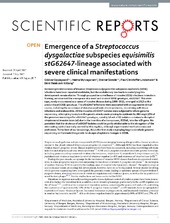Emergence of a Streptococcus dysgalactiae subspecies equisimilis stG62647-lineage associated with severe clinical manifestations
Oppegaard, Oddvar; Mylvaganam, Haima; Skrede, Steinar; Lindemann, Paul Christoffer; Kittang, Bård Reiakvam
Peer reviewed, Journal article
Published version

Åpne
Permanent lenke
https://hdl.handle.net/1956/18081Utgivelsesdato
2017-08-08Metadata
Vis full innførselSamlinger
Originalversjon
https://doi.org/10.1038/s41598-017-08162-zSammendrag
Increasing incidence rates of invasive Streptococcus dysgalactiae subspecies equisimilis (SDSE) infections have been reported worldwide, but the evolutionary mechanisms underlying this development remain elusive. Through prospective surveillance of invasive SDSE infections in western Norway, we observed the emergence of a novel and virulent SDSE genotype, stG62647. This emm-type, rarely encountered as a cause of invasive disease during 1999–2012, emerged in 2013 as the predominant SDSE-genotype. The stG62647-infections were associated with an aggressive clinical course, including the occurrence of streptococcal toxic shock syndrome, necrotizing soft-tissue infections and endocarditis. All the invasive stG62647-isolates were subjected to whole genome sequencing, attempting to explore the genetic events underpinning its epidemicity. Although 10% of the genomes was unique for stG62647-genotype, notably 18 out of 19 isolates contained a disrupted streptococcal invasive locus (sil) due to the insertion of a transposase, IS1548, into the silB-gene. We postulate that the virulence of stG6267-isolates could be partly attributable to the abrogation of the attenuating control normally exerted by this regulon, although experimental verification was not performed. To the best of our knowledge, this is the first study employing large scale whole genome sequencing to illuminate the genetic landscape of epidemic lineages in SDSE.
